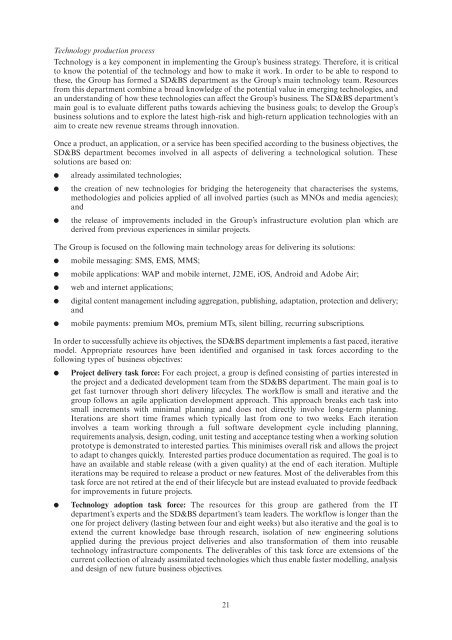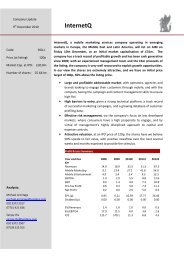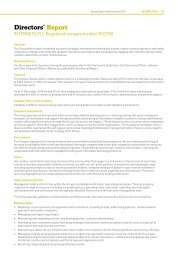Link to Admission Document - InternetQ
Link to Admission Document - InternetQ
Link to Admission Document - InternetQ
You also want an ePaper? Increase the reach of your titles
YUMPU automatically turns print PDFs into web optimized ePapers that Google loves.
Technology production processTechnology is a key component in implementing the Group’s business strategy. Therefore, it is critical<strong>to</strong> know the potential of the technology and how <strong>to</strong> make it work. In order <strong>to</strong> be able <strong>to</strong> respond <strong>to</strong>these, the Group has formed a SD&BS department as the Group’s main technology team. Resourcesfrom this department combine a broad knowledge of the potential value in emerging technologies, andan understanding of how these technologies can affect the Group’s business. The SD&BS department’smain goal is <strong>to</strong> evaluate different paths <strong>to</strong>wards achieving the business goals; <strong>to</strong> develop the Group’sbusiness solutions and <strong>to</strong> explore the latest high-risk and high-return application technologies with anaim <strong>to</strong> create new revenue streams through innovation.Once a product, an application, or a service has been specified according <strong>to</strong> the business objectives, theSD&BS department becomes involved in all aspects of delivering a technological solution. Thesesolutions are based on:●●●already assimilated technologies;the creation of new technologies for bridging the heterogeneity that characterises the systems,methodologies and policies applied of all involved parties (such as MNOs and media agencies);andthe release of improvements included in the Group’s infrastructure evolution plan which arederived from previous experiences in similar projects.The Group is focused on the following main technology areas for delivering its solutions:● mobile messaging: SMS, EMS, MMS;● mobile applications: WAP and mobile internet, J2ME, iOS, Android and Adobe Air;● web and internet applications;● digital content management including aggregation, publishing, adaptation, protection and delivery;and●mobile payments: premium MOs, premium MTs, silent billing, recurring subscriptions.In order <strong>to</strong> successfully achieve its objectives, the SD&BS department implements a fast paced, iterativemodel. Appropriate resources have been identified and organised in task forces according <strong>to</strong> thefollowing types of business objectives:●●Project delivery task force: For each project, a group is defined consisting of parties interested inthe project and a dedicated development team from the SD&BS department. The main goal is <strong>to</strong>get fast turnover through short delivery lifecycles. The workflow is small and iterative and thegroup follows an agile application development approach. This approach breaks each task in<strong>to</strong>small increments with minimal planning and does not directly involve long-term planning.Iterations are short time frames which typically last from one <strong>to</strong> two weeks. Each iterationinvolves a team working through a full software development cycle including planning,requirements analysis, design, coding, unit testing and acceptance testing when a working solutionpro<strong>to</strong>type is demonstrated <strong>to</strong> interested parties. This minimises overall risk and allows the project<strong>to</strong> adapt <strong>to</strong> changes quickly. Interested parties produce documentation as required. The goal is <strong>to</strong>have an available and stable release (with a given quality) at the end of each iteration. Multipleiterations may be required <strong>to</strong> release a product or new features. Most of the deliverables from thistask force are not retired at the end of their lifecycle but are instead evaluated <strong>to</strong> provide feedbackfor improvements in future projects.Technology adoption task force: The resources for this group are gathered from the ITdepartment’s experts and the SD&BS department’s team leaders. The workflow is longer than theone for project delivery (lasting between four and eight weeks) but also iterative and the goal is <strong>to</strong>extend the current knowledge base through research, isolation of new engineering solutionsapplied during the previous project deliveries and also transformation of them in<strong>to</strong> reusabletechnology infrastructure components. The deliverables of this task force are extensions of thecurrent collection of already assimilated technologies which thus enable faster modelling, analysisand design of new future business objectives.21





